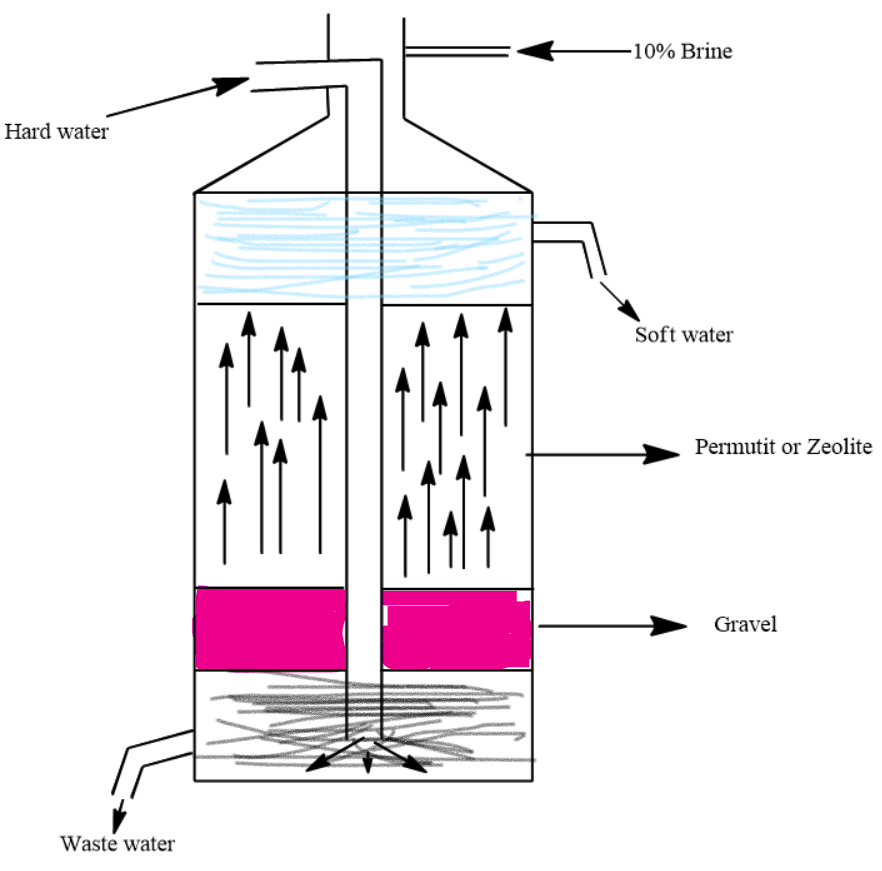
Draw a neat diagram showing the Permutit process of softening hard water and label the following: (a) Zeolite layer (b) Soft water layer.
Answer
504.9k+ views
1 likes
Hint: Try to identify the Zeolite layer in which zeolite is regenerated by passing a brine solution. The soft water layer will be above this zeolite layer which is free from impurities. Calcium and Magnesium zeolites settle at the bottom.
Complete step by step answer:
We know that in the Permutit process salts which cause hardness of water are replaced by salts of sodium. Zeolites are made of aluminates and silicates which can attract many cations. In the Permutit process, we use sodium zeolites for softening hard water. The formula of sodium zeolite is
This sodium zeolite reacts with salts of magnesium and calcium and converts them to magnesium and calcium zeolites.
Here Pm stands for Permutit or zeolite. Similar reactions occur with magnesium salts.
After sometime sodium zeolite is completely converted to calcium and magnesium zeolites so reactions stop. Then, we pass a 10% brine solution through these calcium and magnesium salts to regenerate back sodium Permutit. And we can reuse this Permutit in softening hard water.

The zeolite layer is below the soft water layer.
Note: If there are some transition metal impurities they need to be removed first. In this reaction as there is no precipitate formation, hard water has no obstruction to come into the chamber. It is a fast process and can be easily managed.
Complete step by step answer:
We know that in the Permutit process salts which cause hardness of water are replaced by salts of sodium. Zeolites are made of aluminates and silicates which can attract many cations. In the Permutit process, we use sodium zeolites for softening hard water. The formula of sodium zeolite is
This sodium zeolite reacts with salts of magnesium and calcium and converts them to magnesium and calcium zeolites.
Here Pm stands for Permutit or zeolite. Similar reactions occur with magnesium salts.
After sometime sodium zeolite is completely converted to calcium and magnesium zeolites so reactions stop. Then, we pass a 10% brine solution through these calcium and magnesium salts to regenerate back sodium Permutit. And we can reuse this Permutit in softening hard water.

The zeolite layer is below the soft water layer.
Note: If there are some transition metal impurities they need to be removed first. In this reaction as there is no precipitate formation, hard water has no obstruction to come into the chamber. It is a fast process and can be easily managed.
Latest Vedantu courses for you
Grade 11 Science PCM | CBSE | SCHOOL | English
CBSE (2025-26)
School Full course for CBSE students
₹41,848 per year
Recently Updated Pages
Master Class 9 General Knowledge: Engaging Questions & Answers for Success

Master Class 9 English: Engaging Questions & Answers for Success

Master Class 9 Science: Engaging Questions & Answers for Success

Master Class 9 Social Science: Engaging Questions & Answers for Success

Master Class 9 Maths: Engaging Questions & Answers for Success

Class 9 Question and Answer - Your Ultimate Solutions Guide

Trending doubts
State and prove Bernoullis theorem class 11 physics CBSE

Who built the Grand Trunk Road AChandragupta Maurya class 11 social science CBSE

1 ton equals to A 100 kg B 1000 kg C 10 kg D 10000 class 11 physics CBSE

State the laws of reflection of light

One Metric ton is equal to kg A 10000 B 1000 C 100 class 11 physics CBSE

Difference Between Prokaryotic Cells and Eukaryotic Cells




